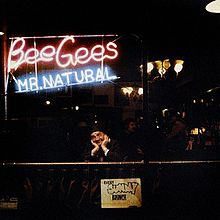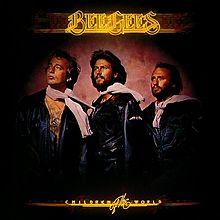Little is widely known about the minutiae of how the Bee Gees evolved from producing string-laden ballads in the late 60s to the dance floor grooves in the late 70s. The recent 1974-79 box set goes some small distance towards remedying this. Hopefully this blog will do more.
NOTE: Though the box set covers the Saturday Night Fever tracks and the 1979 album Spirits Having Flown, I have already covered the latter of these in a recent entry and can see little reason to retread the familiar territory of Stayin’ Alive etc. This entry therefore looks at the evolution of the Bee Gees sound over the three studio albums released 1974-76.
DISCLAIMER: All images imported from Wikipedia based on their fair usage guidelines. All copyrights hereby acknowledged.
By 1973 the Bee Gees were in trouble. Having reformed in 1970 after a two year period of recording separately, Barry, Robin and Maurice Gibb had found hits harder and harder to come by, especially in their native Britain. The more country-oriented Life in a Tin Can stiffed (although the single Saw A New Morning was a chart-topper in Hong Kong) and the intended follow-up A Kick In The Head Is Worth Eight in the Pants was deemed unsuitable for release though whether by the brothers or Atlantic Records remains unclear.
But manager Robert Stigwood wasn’t giving up. He took the advice of Atlantic’s in-house producers Jerry Wexler and Ahmet Ertegun (nicknamed Urtme Armagain by the brothers) and assigned the brothers to work with legendary soul producer Arif Mardin, firstly in the familiar environs of IBC studios in London but eventually in Atlantic’s own studio in New York City, more familiar territory for Mardin and highly prophetic territory for the Bee Gees.
Mr. Natural (1974) was later described by Maurice (I think) as an album that “one used as a frisbee”. It also achieved by far the group’s lowest placing on Billboard but the truth of the matter was that it was by far the Bee Gees’ best album since their late 60s heyday. That said, it was a complete stylistic departure. While the string-drenched sound of their early hit had suited those songs perfectly, the fact was that the brothers’ songwriting had lost a lot of depth since then, not least due to their fall-out with each other in 1969. They’d buried the hatchet and reformed the following year but it took quite a while for them to get used to writing together again. The quirky psychedelia of albums like Bee Gees 1st and the depth of hits like Words and I Started a Joke had deserted them and instead came lightweight love ballads like Run To Me. But Robert Stigwood was wise to the fact that the brothers had been influenced greatly by soul music, indeed some early hits were written with the likes of Otis Redding and Percy Sledge in mind, and with bands like the Three Degrees and the Stylistics riding high in the charts and the Philadelphia sound of artists like Harold Melvin and the Bluenotes as well, it was time for the Bee Gees to go back to their roots. To that end, Arif Mardin was the perfect choice to produce this album.
And what an album it was! Right from the opening electric piano on the sensual love-on-the-sand ballad Charade you could tell this was a new chapter. Indeed the Bee Gees once again had the advantage of a strong backing band. Alan Kendall who had played lead guitar with them since Trafalgar in 1971 was now joined by former Amen Corner drummer Dennis Bryon and keyboard player Geoff Westley who here took on piano duties freeing up Maurice Gibb to focus on mellotron and organ while continuing as bass player. Westley was no stranger to RSO (Robert Stigwood Organisation) having functioned as musical director for the original West End run of Jesus Christ Superstar which Stigwood was promoter for. Throw a Penny and Voices had a political bent about the wisdom of children, both tying in with the inclusion of Give A Hand, Take A Hand which Barry and Maurice had given to P P Arnold in 1969. Throw a Penny also served as the first half of a medley, leading into Down the Road which seriously rocked and merited a place on the brilliant live album Here at Last (1977), taking Barry’s lyrical country leanings into a new edgy territory. But Barry’s country leanings weren’t completely forgotten as the gorgeous Lost In Your Love, written by Barry alone, proved but this time there was a rocky assurance to the sound – no longer did it sound like it would be playing on a tacky market stall. They were rocking like never before on I Can’t Let You Go and Heavy Breathing while Had A Lot Of Love Last Night proved they hadn’t lost the art of a good ballad.
The result was so positive that Arif Mardin was kept on for the next album. But once again a lesson from a fellow veteran proved invaluable – not long after Mr. Natural, the band’s fellow Stigwood alumnus Eric Clapton had released his triumphant comeback album 461 Ocean Boulevard recorded at Criteria Studios in Miami. Stigwood showed the Bee Gees the cover of this album and recommended they try the environment out.
The change of scene worked and on the resulting Main Course album (1975) the Bee Gees began to embrace the R & B sound wholeheartedly. The first single, Jive Talkin’ was launched on an unsuspecting public and equally unsuspecting DJs who were played the record without being told who it was. Any threat of the Bee Gees being confined to the 1960s dustbin was gone with the percussive groove that kicked off the song, inspired by the sound of their car going over a bumpy stretch of road in Miami, Barry’s chunky rhythm guitar and new keyboard sidesman Blue Weaver’s diddly-dee solo. Jive Talkin’ was an instant smash in many countries, most notably returning them to the UK charts after a three-year absence, peaking at No 5 and topping the charts in the US and Canada. Its flip side, Wind of Change, also included on the album, set a template for much of what followed with string synthesisers and an anthem of hope for the Big Apple at its worst. Maurice’s bass had moved from emulating McCartney to some seriously funky runs and with an array of percussion and saxophone solos, this wouldn’t have sounded out of place in a gangster movie of the time.
But it was the opening track, Nights on Broadway, that really got the disco-era Bee Gees going (much as they always objected to that label being stuck on them) with the band on full tilt and the very first falsetto leads from Barry – one of Mardin’s most inspired ideas was to suggest that Barry try to “scream in tune” for this one. It gave them another hit and though sadly it didn’t chart in the UK, this was made up for when a recording by Candi Staton went to No 6 there in 1977.
The only other track that would really appeal to R & B listeners was the third single Fanny (Be Tender With My Love) where the new-style backing was applied to a love song albeit not of the kind one was used to from the brothers. It was around the time this single was out that the album spent a week at #1 in Canada. Canada was kinder to this album than probably any other territory – Nights on Broadway and Fanny both peaked at #2.
The biggest trump card up their sleeve was probably the replacement of Geoff Westley with another ex-Amen Corner alumnus in Derek “Blue” Weaver. Weaver’s electric keyboard sounds became a cornerstone of the Bee Gees sound over the ensuing decade brightening up later hits like How Deep Is Your Love and Too Much Heaven. His intro to Nights on Broadway sets the tone for the new era of Bee Gee music and indeed the first half of the album perfectly and on Songbird he even merited a co-composer credit alongside the Gibbs, one of only a small handful of musicians to achieve this honour.
The rest of the album sounds more like a band still trying to shed its old sound. All This Making Love and Baby As You Turn Away show that while the Gibbs had got the hang of a new sound, they still had yet to regain much of the lyrical sophistication of their heyday. But the Robin-led piano ballad Country Lanes and the psychedelic sci-fi tale Edge of the Universe both merit a mention here while another Robin/piano track Come On Over became a hit for Olivia Newton-John. But in spite of any weaknesses, Main Course went platinum, the first Bee Gees album to do so.
It came as a shock to them therefore that Robert Stigwood decided to move RSO across from Atlantic back to its former home at Polydor. This meant leaving Arif Mardin behind (though he would return to co-produce the E-S-P album in 1987) as he was employed by Atlantic but he told them they were more than ready to return to self-producing. So the Bee Gees stayed at Criteria Studios and hired the engineering/production team of Karl Richardson and Albhy Galuten to accompany them in their quest. The result was Children of the World released in 1976.
The first single You Should Be Dancing proved that the relaunched Bee Gees were no one night stand. Now they were doing disco whether they liked it or not right from Maurice’s funky bass intro and the band were seriously kicking as were the horn section. The flip side was Subway which deepened the New York theme as Travolta’s steps cam ever closer.
Now virtually all traces of Beatles influence were gone and everything sounded like it could have been emanating from a nightclub in Miami or Manhattan even if on songs like Boogie Child and Can’t Keep A Good Man Down they were trying a bit too hard to sound macho. But their ballads were getting back to the glories of old even if not the sound of old. You Stepped Into My Life and the second single Love So Right were perfect love songs enhanced not least by Barry’s falsetto while Robin’s quavery vocal got practically its only outing of the Bee Gees R&B era on Love Me with Barry chipping in as the singer’s conscience towards the end.
The only hark-backs to earlier sounds were another Weaver-assisted composition The Way It Was and the anthemic title track, famously used in Kenny Everett’s DIY Bee Gees kit sketch and revived for the band’s Millennium Eve concert in Miami. The song still stands as something of a calling card for the band. One thing that united the brothers even when their relationships weren’t at their best was their belief that children are important, are the future and will be “till the very last day when the curtains are drawn” and this song is just as much testament to that as their performance at UNICEF and their donation of the royalties from Too Much Heaven to that charity.
The Bee Gees were well and truly back on the charts with a bold new sound and the promise of more hits to come. The new sound would reach its full consummation on their contributions to the Saturday Night Fever soundtrack and the transatlantic #1 album Spirits Having Flown.


